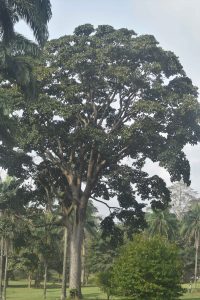 One tree that stands out above all others in the IITA Ibadan campus is the iroko Milicia excelsa. There are large solitary trees in the fields, on the Golf Course, near residential and administrative buildings, and even in the hotel car park. They were left standing when the original forest was cut down because the Yoruba people regarded them as sacred. Now they are among the last in Nigeria and on the IUCN Red List status as NT (Near Threatened).
One tree that stands out above all others in the IITA Ibadan campus is the iroko Milicia excelsa. There are large solitary trees in the fields, on the Golf Course, near residential and administrative buildings, and even in the hotel car park. They were left standing when the original forest was cut down because the Yoruba people regarded them as sacred. Now they are among the last in Nigeria and on the IUCN Red List status as NT (Near Threatened).
Iroko is a forest giant, reaching 50m in height, 10m in circumference and often not branching for the first 20m. It is valued for timber and as an icon of traditional beliefs. In parts of Nigeria, people believe that an iroko was the first tree that God showed to human beings and that it brings forth souls for the newborn. A strong man may be given the nickname Iroko. Medicinal uses are important locally. The bark has analgesic effects, and the gum that oozes from cracks in the bark is a good antiseptic.
Some iroko trees are male and others are female. They are easy to tell apart at the end of the dry season when males produce long dangling catkins and females bear green sausage-shaped fruits that attract hundreds of bats every evening for weeks. An iroko seed is the size of a pinhead. Juvenile trees have soft, delicate leaves and are slow growing. They are very sensitive and need the shade and shelter of the forest. It can take 130 years for an iroko to reach 80cm in diameter so IITA’s lone trees are very old indeed.


